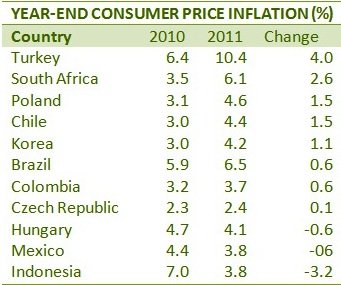A different perspective might be useful
After all, price stability (or anti-inflationary policies) is among the chief aims of the CBT.
The last two inflation reports by the Central Bank of Turkey (CBT) have the same graphs as Figure 1. It appears that the message it delivers is of key importance for the CBT. The graph compares the value of the lira with ten emerging market currencies since October 2010, when the new monetary policy framework was launched. Emerging market economies referred to are Brazil, Chile, Czech Republic, Hungary, Mexico, Poland, S. Africa, Indonesia, Korea and Colombia. Before the graphs, repots explain: “...(The CBT) also reacted to excessive exchange rate deviations from economic fundamentals on either side.” Right after this sentence, readers are guided to the figures.
Value of lira lowered
CBT officials and reports stress via these graphs that the value of lira was lowered (that is, exchange rate was allowed to increase) with the measures introduced in October 2010. This way, other emerging market currencies appreciated until mid-2011 and thus these economies lost competitiveness while successful attempts to depreciate the lira has built on Turkey’s competitiveness, in line with the policy to tackle the high current account deficit. In addition, it is claimed, the extreme volatility in the value of emerging market currencies especially in the second half of 2011 was not observed in the dollar or euro exchange rate of the lira, which is a positive development in terms of financial stability.
The table below shows the year-end CPI for 2010 and 2011 in the selected countries and in Turkey. The last column shows the change in CPI between 2010 and 2011. Countries are ranked in descending order by the rate of increase in CPI between 2010 and 2011. The ranking does not change if we focused the level instead of the change. In both cases, Turkey ranks on top by landslide. Another point: In 2010, Indonesia’s CPI was higher than that of Turkey, followed by Brazil with a CPI only 0.5 points lower. In 2011, however, the difference between the CPI in Turkey and in South Africa right after Turkey was 4.3 points.
You cannot make a one-sided analysis
Non-energy current account deficit has been decreasing and the pace of credit supply growth is in decline. Current account deficit finance has been shifting towards longer-term funds. These all are correct and favorable developments. We have been learning these at length in CBT reports and presentations. What is more, the press and columnists cite these as the achievements of the new monetary policy framework.
You cannot make a one-sided analysis, however. The CBT and columnists praising the monetary policy framework must now and then evaluate the monetary policy with a different perspective. And they do not need to tear the place apart to come up with a new perspective. After all, price stability (or anti-inflationary policies) is among the chief aims of the CBT. Why not assess the monetary policy in terms of its effectiveness in fighting against inflation? Such perspective brings us to the picture at the below table. There is another “thing” as important as the below picture but I will deal with that on Thursday.

This commentary was published in Radikal daily on 08.05.2012




